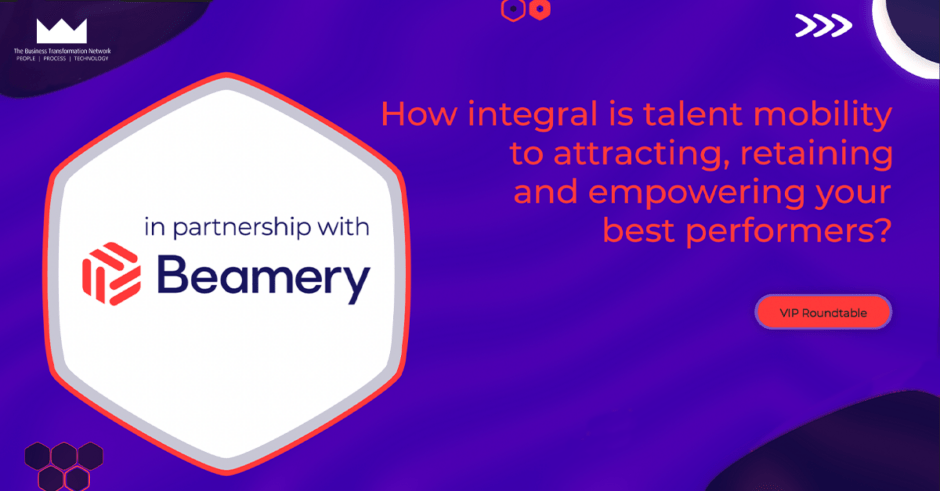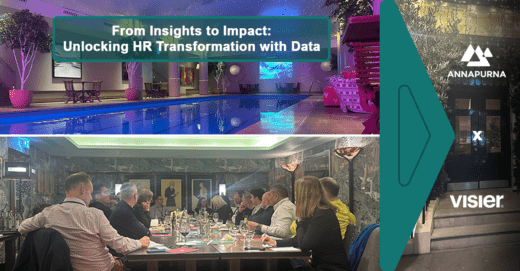The BTN was recently delighted to partner with Beamery, a talent lifecycle management platform for a fascinating roundtable around how integral talent mobility is to attracting, retaining and empowering your best performers. The session was hosted by the sensational Matt Smith (Regional Vice President of Sales at Beamery) and James Ballard (Founding Partner and Executive Lead at Annapurna Recruitment), which brought about the following takeaways.
Talent mobility has been around for many years, however, many HR and business leaders are only just beginning to understand the true benefits of a well-designed talent mobility program. Beamery’s recently published report, Talent Index 5, discovers employee perceptions including their desire to try new roles and gain new skills within their current organisation. For instance, as many as 80% will stay with employers if access to new roles/internal promotions is improved. Finding and keeping the best talent is becoming a strategic imperative for many organisations, in particular the four big accounting firms.
Internal mobility has different challenges depending on the level of the employee
Attracting, engaging and retaining employees is essential for securing a successful future for your organisation, particularly when it comes to using internal candidates as the biggest untapped resources in business. Not only do internal hires tend to be high performers, but compared to external hires, they’re also more likely to stay within the organisations. This is where workforce planning becomes essential when it comes to empowering your best performers, especially because talent pools are limited in certain areas and roles could take longer to fill.
For many organisations, the skill gap is essential as it helps boost learning and development for individuals. However, defining the skills gap comes with many challenges, particularly because you can only plan between 12-18 months and no further, due to the rapid changes in the market. The question simply comes down to, how can they utilise people’s skills. How does what they do today, match what they want to do in the future? The point was raised that you need to build that vision in order to identify what it is that you need to get there. Internal mobility is more important now than it ever has been and this is because it supports career agility by moving employees onto new roles, tasks, and even coaching so they can grow more agile as people and team members. Finding internal talent is much easier and more effective than finding external talent but the journey to get there requires planning and bringing everyone on that same journey.
When it comes to more senior employees such as C-suite professionals, they may be able to unblock and encourage movements which will help the overall share price go up, as well as the overall performance of the business. On the flip side, for more junior employees, the question may be asked about what the incentive is for hiring managers to let their star performers move to other teams or departments. This is further exacerbated when the employees are client-facing and revenue-generating. Despite this, firms could be able to establish a culture around talent by simply showing a level of appreciation and celebration towards managers who enable internal mobility.
Knowing an employee’s skills is integral to enabling talent mobility
As organisations review their mobility approaches to deal with things like HR implications, it is integral that employees’ skills are considered to enable talent mobility. Leading employers understand the importance of placing employees’ professional development at the heart of the company policy, simply because their workers expect it. Talented professionals are keen to work for firms that are able to provide opportunities for them to grow and build the necessary skills and knowledge to further their careers. Therefore we must be demonstrating the importance of having those open conversations about exactly how they can get there. If this is not provided by the organisation, then they may lose out on long-term talent and future leaders as employees will begin to look elsewhere.
Programmes have been hurt by over-zealous employees claiming they have a multitude of skills, but when it comes to the move to a different role, the lack of some of those skills, or a depth of knowledge, becomes a blocker. It undermines confidence in a process that already has significant blockers. In spite of that, this differs depending on the level of the employees who might be moving.
So how can you challenge this? Beamery helps the world’s largest and most innovative companies create more human talent experiences and unlock the skills and potential of their global workforce. They are the only ethical AI-powered talent platform that powers faster recruiting, successful talent mobility, redeployment of key skills, smarter upskilling and agile workforce planning. Beamery is able to create a personalised experience across the entire talent lifecycle, with a human-centred AI that will help you find, develop and retain talent. According to Beamery’s studies, 79% of business leaders state that AI has the potential to transform how they approach talent.
Don’t lose a good employee to a competitor
Talent marketplaces connect employees with career opportunities and resources for professional growth. When it comes to upskilling and business resilience, talent marketplaces have to be automated and tested to ensure data is kept up to date. Talent marketplaces are a complete cultural mindset shift, the data can change it but it simply comes down to how organisations can embrace it. Embracing culture is key within all firms and it is important that all organisations are able to embrace it to facilitate development and nurture leaders and the people they work with. This can simply be done by offering a reward whether that be flexible working, extra leave, volunteering days and more. Rewards are an essential component as they can help businesses attract and retain their employees whilst also improving organisational culture, performance, recognition and work-life balance.
When an external candidate is hired, there is more focus on what skills are really needed and how they will be assessed. Yet, the process isn’t as thought through when it comes to internal moves. This can usually be because it is much cheaper and faster to recruit internally than it is externally as it leverages employees that you already have. Nevertheless, there is not as much unbiased assessment as for external hires, which can therefore damage the process.
Despite this, all managers being incentivised to hire for potential is vital. The more appreciation for “squiggly careers” the better to promote internal mobility. It is therefore paramount that firms do not lose a good employee to a competitor where DEI could be the driver, for example.
Workforce planning is essential when it comes to empowering your best performers. Once organisations are able to do this successfully, they will be able to attract, and retain their best performers, whilst also increasing business success.
About Beamery
Beamery’s Talent Lifecycle Management platform allows enterprises to create more human experiences for all talent, and unlock the skills and potential of their global workforce. We help organizations identify and acquire top talent, move the needle on DE&I, close key skill gaps and retain top performers. We’re on a mission to create equal access to work.
Leveraging an industry-first AI-powered Talent Graph, Beamery’s Talent Lifecycle Management platform helps organisations realise their business potential. They can identify and prioritise candidates that are likely to thrive at their organisation, reach diversity targets, unlock career ambition opportunities for existing employees, and understand the skills and capabilities they need to build their workforce of the future.
Beamery is one of the world’s fastest-growing companies, and we’re excited to have recently raised a $138m Series C.



